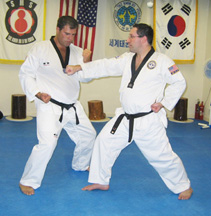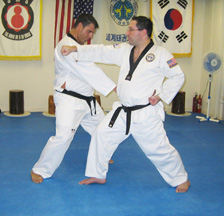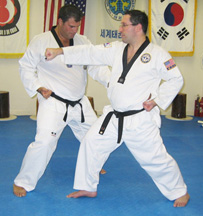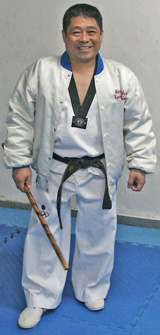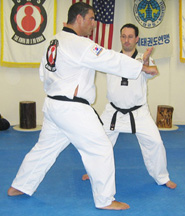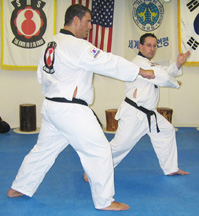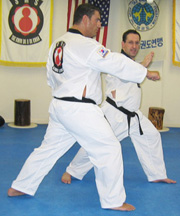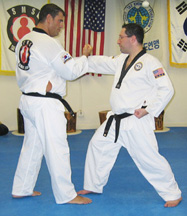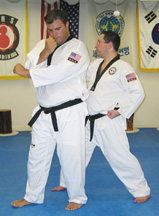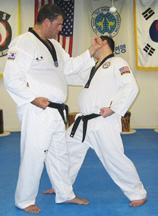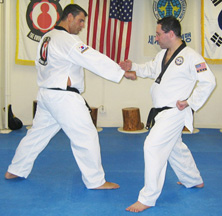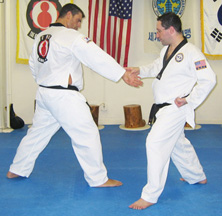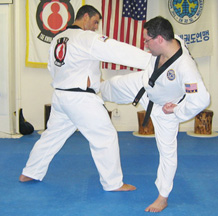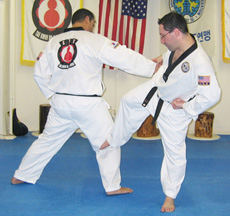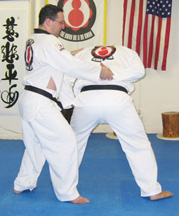The philosophy of Taekwondo is very special, but what makes it so special? If we learn philosophy from books, we tend to forget it as soon as we leave them, because it is not related to our actual lives. But since Taekwondo is connected with our lives like every movement of ours is, we can never forget its philosophy.
That is, the philosophy is one of actions that can be learned from other actions, and our everyday activities. Taekwondo philosophy represents the principles of the changes and movements in human beings. It also represents the principles of our lives, since life consists of our movements. Therefore, we can say Taekwondo is a philosophy in itself. We can understand the philosophy of Taekwondo by doing Taekwondo, and this understanding should lead to better understanding and enhancement of our life. The principles of Taekwondo can be explained in several ways but here we will explain it simply with the principle of “Sam Jae” [Three Elements] and that of “Eum” [the Negative or Darkness] and “Yang” [the Positive or the Brightness]. “Sam Jae” refers to “Cheon” [the Heaven], “Ji” [the Earth], and “In” [the Man] and the principles concerning them. In oriental countries, it has been recognized as the central principle that explains the changes of everything in the world. “Sam Jae” and the changes of “Eum” and “Yang” constitute the “Eight Trigrams for Divination” in the “Book of Changes.” The principle of Sam Jae has been emphasized in oriental countries, especially in Korea. If you understand Taekwondo’s principle, you could understand all the skills and spiritual depth of Taekwondo. The principle of Eum and Yang has also been emphasized in oriental countries as the central principle of life. It maintains that everything has an opposite side. This principle explains various forms of changes, but it comes from “Taegeuk” [the Great Absolute], which represents the ultimate claim that Eum and Yang was the one and the same thing. If we understand Taekwondo according to this principle, we will find a solution, and by continuously changing skills, we will never get stuck, in any situation. After we understand these philosophical principles of Taekwondo, we can find proper ways to understand and develop our lives.
The Historical Development of Taekwondo Philosophy
What is the philosophy of Taekwondo? Taekwondo contains thoughts that Han [Korean] people had developed through history. Its philosophy is easily explained with Hongik-Ingan, Jaese-Ihwa, or Hwarangdo spirit. Hongik-Ingan and Jaese-Ihwa were not only ideologies of Tangun Chosun’s foundation, but also a fundamental thought of Han people. With time, these ideas developed into the Hwarangdo spirit and the Taekwondo philosophy today. Now, let’s look at the principles contents of the philosophy.
Hongik-Ingan” means universal welfare of mankind. It was the idea of the national foundation by Tangun, and the Taekwondo spirit too has inherited the idea of Hongik-Ingan. It is easily confirmed from the fact that the word of Taekwondo, itself means to suppress fighting and induce peace. On one hand, Jaese-Ihwa means that the world is educated in accordance with the reason of heaven. Taekwondo is a principle, not a simple connection with movements. It is the Korean traditional martial art characterized by the trinity of body, mind and life. Thus, the principle is the reason of all creation, and so it refers to the reason of heaven in Jaese-Ihwa. Therefore, human beings can be educated in accordance with the reason of heaven through correct training of Taekwondo. That’s the very meaning of Jaese-Ihwa. Hongik-Ingan and Jaese-Ihwa appear clearly in the myth of the Korean foundation. According to it, “In the early age, Hwan-Wung, the son of Heaven established a nation called Baedal [earliest name of Korea]. He then announced the purpose of the national foundation as Jaese-Ihwa [educate with the reason of heaven] and Hongik-Ingan [universal welfare of mankind].
Philosophical Principles of Taekwondo
The philosophy of Taekwondo is very special, but what makes it so special? If we learn philosophy from books, we tend to forget it as soon as we leave them, because it is not related to our actual lives. But since Taekwondo is connected with our lives like every movement of ours is, we can never forget its philosophy.
That is, the philosophy is one of actions that can be learned from other actions, and our everyday activities. Taekwondo philosophy represents the principles of the changes and movements in human beings. It also represents the principles of our lives, since life consists of our movements. Therefore, we can say Taekwondo is a philosophy in itself. We can understand the philosophy of Taekwondo by doing Taekwondo, and this understanding should lead to better understanding and enhancement of our life. The principles of Taekwondo can be explained in several ways but here we will explain it simply with the principle of “Sam Jae” [Three Elements] and that of “Eum” [the Negative or Darkness] and “Yang” [the Positive or the Brightness]. “Sam Jae” refers to “Cheon” [the Heaven], “Ji” [the Earth], and “In” [the Man] and the principles concerning them. In oriental countries, it has been recognized as the central principle that explains the changes of everything in the world. “Sam Jae” and the changes of “Eum” and “Yang” constitute the “Eight Trigrams for Divination” in the “Book of Changes.” The principle of Sam Jae has been emphasized in oriental countries, especially in Korea. If you understand Taekwondo’s principle, you could understand all the skills and spiritual depth of Taekwondo. The principle of Eum and Yang has also been emphasized in oriental countries as the central principle of life. It maintains that everything has an opposite side. This principle explains various forms of changes, but it comes from “Taegeuk” [the Great Absolute], which represents the ultimate claim that Eum and Yang was the one and the same thing. If we understand Taekwondo according to this principle, we will find a solution, and by continuously changing skills, we will never get stuck, in any situation. After we understand these philosophical principles of Taekwondo, we can find proper ways to understand and develop our lives.
The Historical Development of Taekwondo Philosophy
What is the philosophy of Taekwondo? Taekwondo contains thoughts that Han [Korean] people had developed through history. Its philosophy is easily explained with Hongik-Ingan, Jaese-Ihwa, or Hwarangdo spirit. Hongik-Ingan and Jaese-Ihwa were not only ideologies of Tangun Chosun’s foundation, but also a fundamental thought of Han people. With time, these ideas developed into the Hwarangdo spirit and the Taekwondo philosophy today. Now, let’s look at the principles contents of the philosophy.
Hongik-Ingan” means universal welfare of mankind. It was the idea of the national foundation by Tangun, and the Taekwondo spirit too has inherited the idea of Hongik-Ingan. It is easily confirmed from the fact that the word of Taekwondo, itself means to suppress fighting and induce peace. On one hand, Jaese-Ihwa means that the world is educated in accordance with the reason of heaven. Taekwondo is a principle, not a simple connection with movements. It is the Korean traditional martial art characterized by the trinity of body, mind and life. Thus, the principle is the reason of all creation, and so it refers to the reason of heaven in Jaese-Ihwa. Therefore, human beings can be educated in accordance with the reason of heaven through correct training of Taekwondo. That’s the very meaning of Jaese-Ihwa. Hongik-Ingan and Jaese-Ihwa appear clearly in the myth of the Korean foundation. According to it, “In the early age, Hwan-Wung, the son of Heaven established a nation called Baedal [earliest name of Korea]. He then announced the purpose of the national foundation as Jaese-Ihwa [educate with the reason of heaven] and Hongik-Ingan [universal welfare of mankind].

